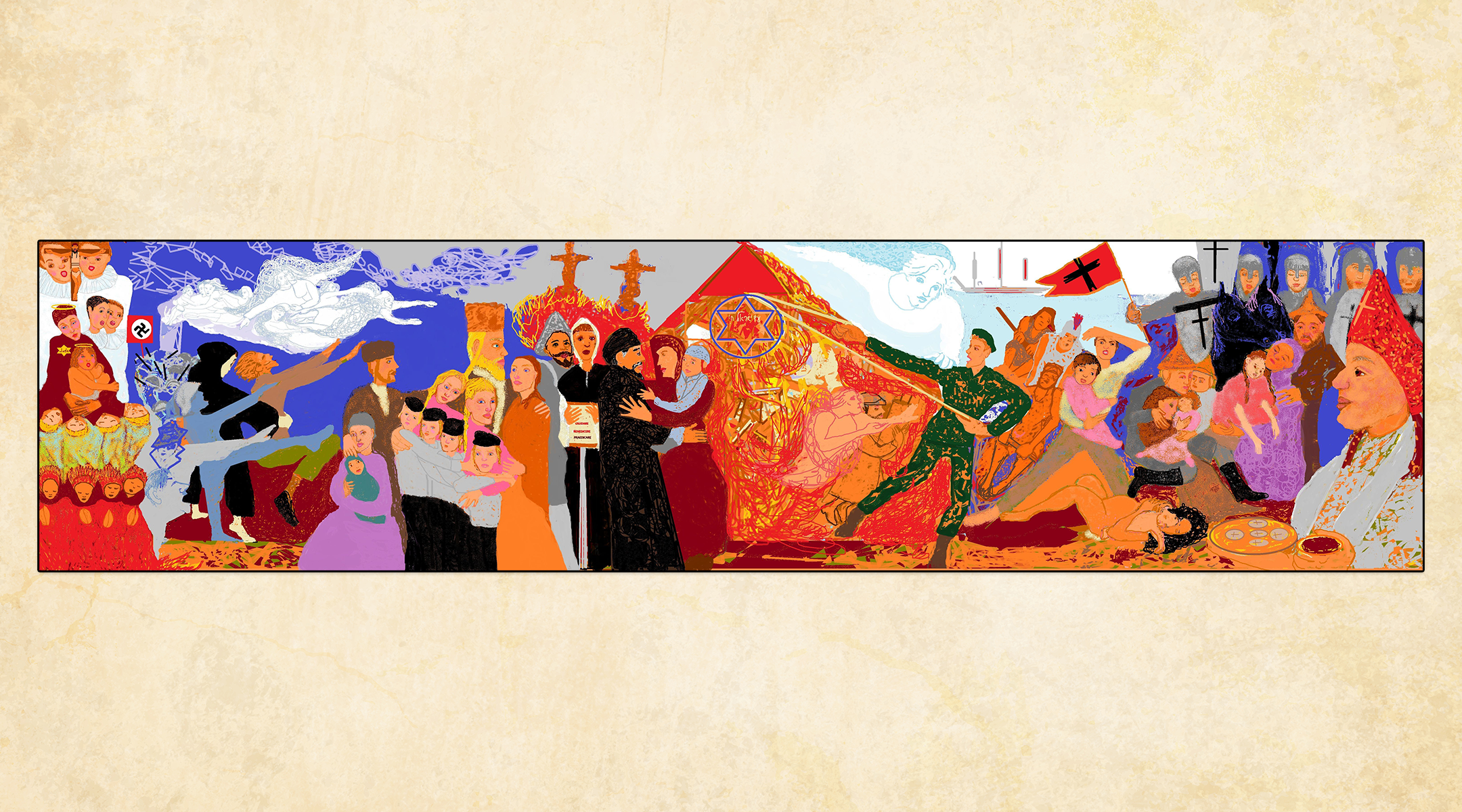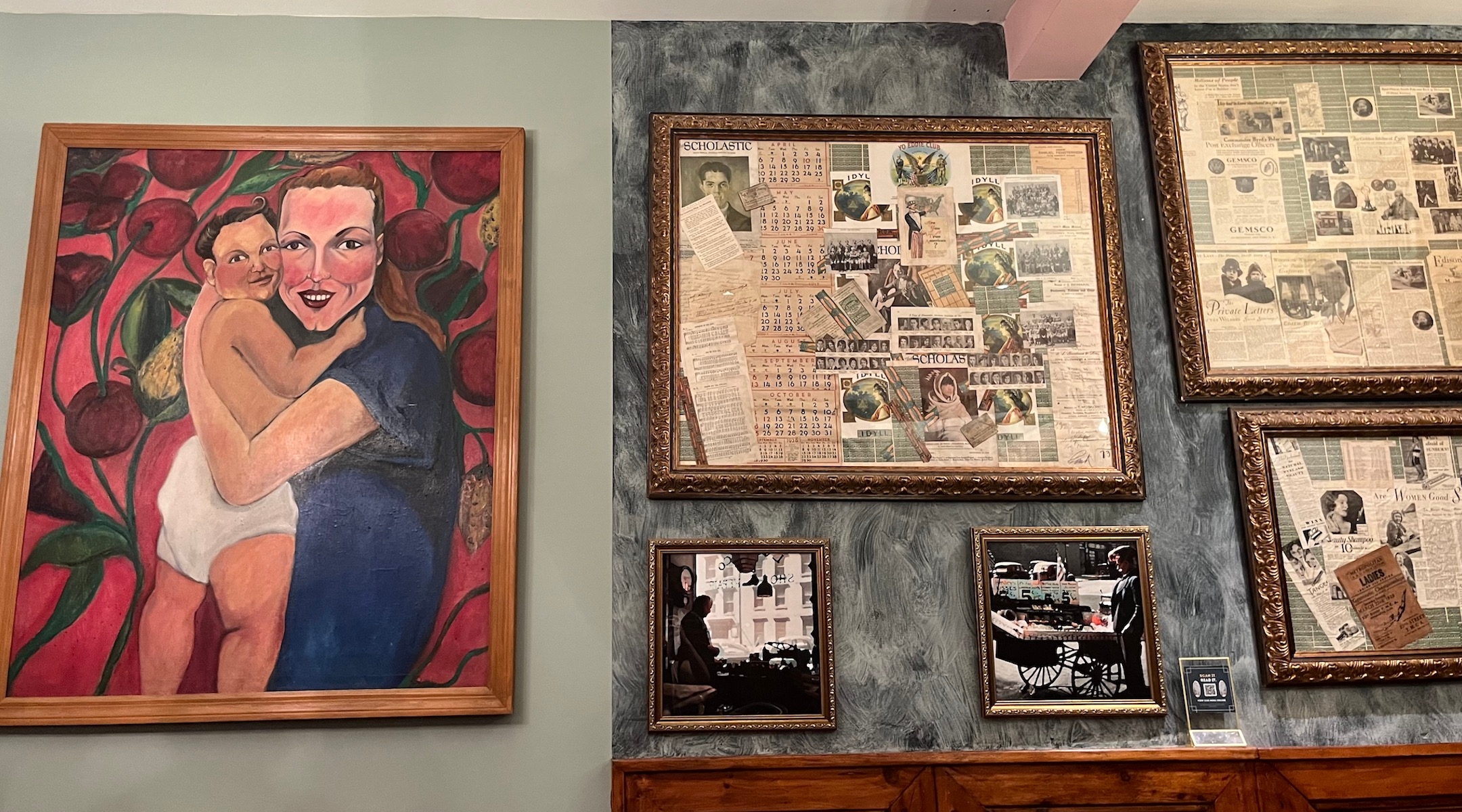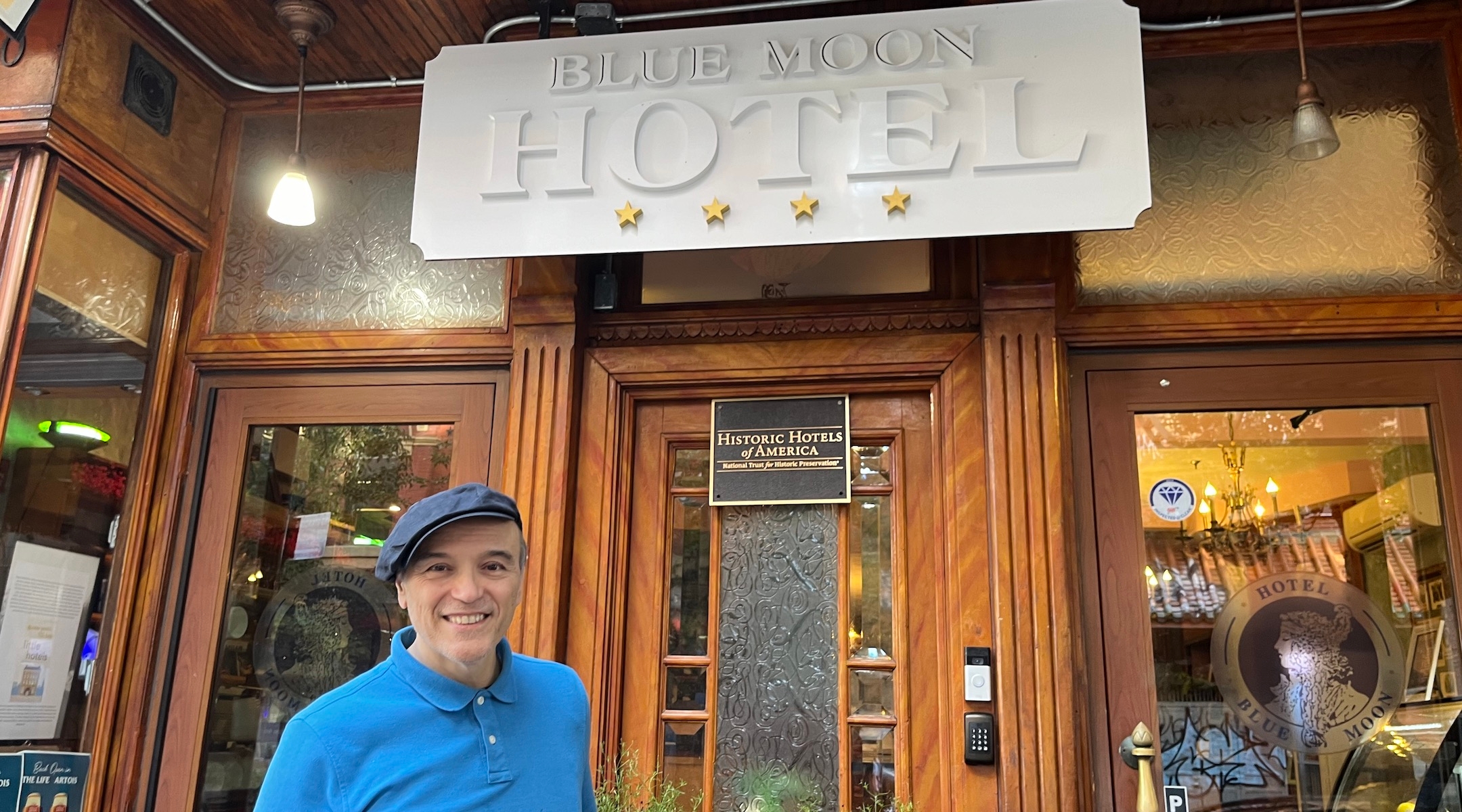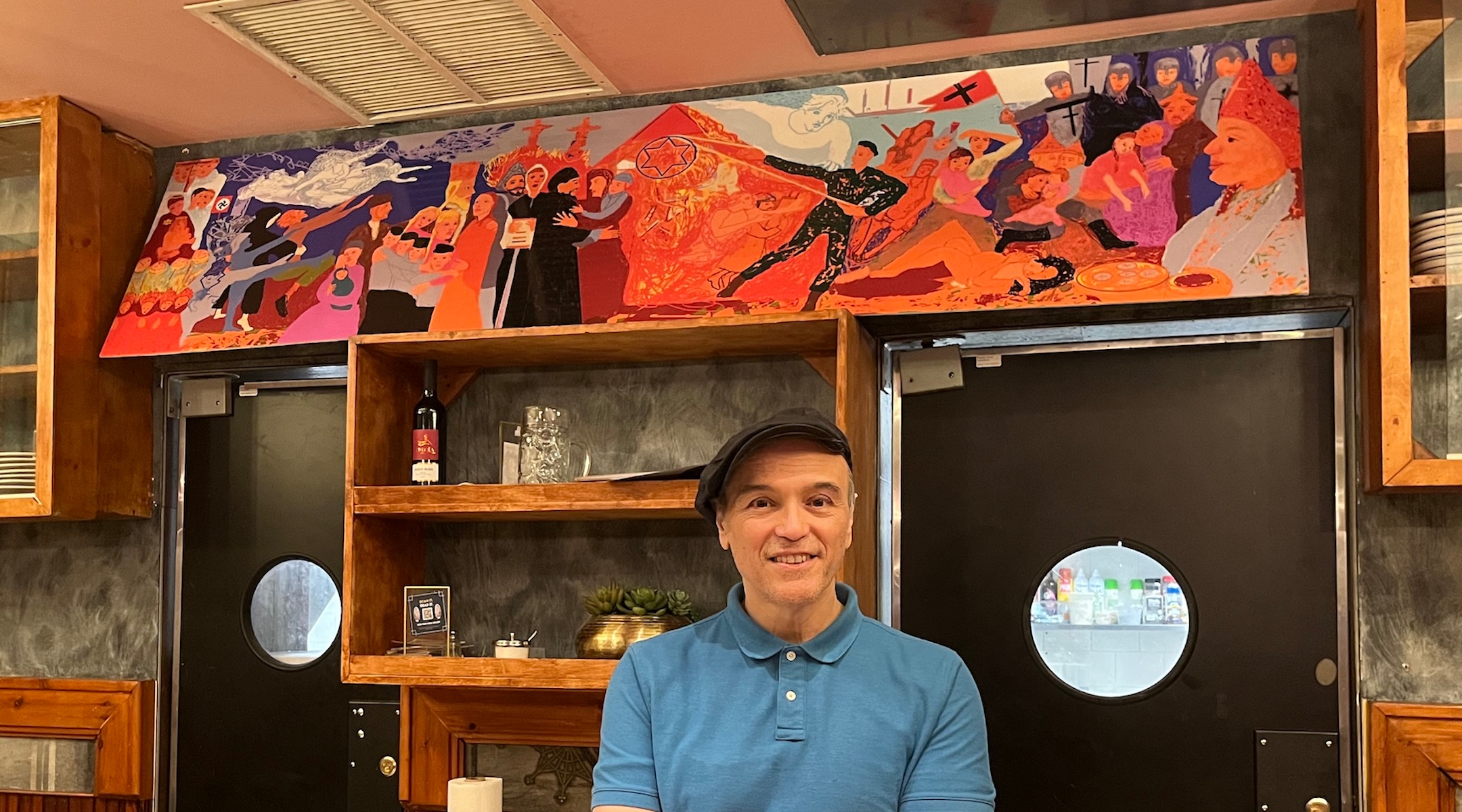Tucked away on a busy stretch of Orchard Street in New York City’s Lower East Side is a kosher Italian restaurant called Sweet Dreams Cafe. Inside hangs a large-scale painting that is the stuff nightmares are made of: a colorful mural depicting 2,000 years of tragedies that have befallen the Jewish people.
The painting is by Randy Settenbrino, an Orthodox Jewish artist who also owns the cafe. It depicts the horrors of Jewish history, including the Babylonian exile, the auto-da-fés of the Spanish Inquisition and the deadly Nazi regime. A section also commemorates the artist’s family members who were buried alive during the Holocaust.
“I’ve always known that there is a certain amount of anti-Semitism in the world,” Settenbrino told New York Jewish Week last week. “My response to that has always been to be more blatantly and decisively Jewish.”

A painting depicting 2,000 years of anti-Semitism hangs in the dining room of the lobby of the Blue Moon Hotel. (Courtesy of Randy Settenbrino)
That’s not the only art at Sweet Dreams Café. Throughout the eatery, which serves Italian specialties like pasta and panini, dozens of Settenbrino’s paintings adorn the walls, including portraits of his six children and biblical figures like Adam and Eve and the priest Itamar.
The Lower East Side, through which hundreds of thousands of Jewish immigrants cycled in the late 19th and early 20th centuries, has a long, rich tradition of Jewish restaurants, institutions and small shops. Survivors include Yonah Schimmel’s Knish Bakery and Katz’s Delicatessen. But even the most hardened New Yorker might be surprised to find a very Jewish business on Orchard Street that they probably didn’t know about: Not only is Jewish art hidden inside a kosher cafe, but the cafe itself is on the ground floor of the Blue Moon Hotel, an 1879 tenement building that has been modernized and decorated to honor the neighborhood’s Jewish character of yore.
“We are committed to the Jewish community in every way we can,” Settenbrino said, looking out over Orchard Street from the top-floor balcony of the Molly Picon Room, named after the star of the Yiddish stage and screen.
Of course, remembering Jewish history does not mean that Settenbrino, a vocal supporter of Israel, can escape it, especially at a time of heightened tensions over the war in Gaza. And indeed, protesters have learned about Settenbrino and his hotel. But more on that in a moment.
Settenbrino has operated the hotel since 2006, along with the cafe and art gallery. Each room in the 22-room hotel is named after a different 20th-century entertainment icon, such as comedian Eddie Cantor and singer Sophie Tucker. The walls of the hallways and lobby are decorated with collages of Jewish ephemera and personal items, from a schoolboy’s Yiddish homework to posters for Yiddish theater to maps of New York City and historical photos of Lower East Side residents in the 1940s and 1950s by photographer Rebecca Lepkoff.
Before Settenbrino bought the eight-story building, The shop on the first floor was used by traders who sold cheap goodsThe apartments on the upper floors were deserted and full of junk, much of which Settenbrino rummaged through for the collages.
“They tell the story of the lives that were lived, loved and lost here,” Settenbrino told New York Jewish Week.
Settenbrino said he spent five years renovating the building before opening it in 2006. First, he cleared away decades of rubble, then installed an elevator and renovated the rooms. He replaced the original wooden apartment doors, which no longer met fire codes, as bathroom doors and used the wrought iron from the former fire escapes for the balconies.
“He has done something truly remarkable: he has restored this tenement building and made it a symbol of the community again, especially by opening the kosher Italian restaurant as part of that work,” Jason Guberman, executive director of the American Sephardi Federation and adviser to the Lower East Side Jewish Conservancy, told New York Jewish Week.
Support New York Jewish Week
Our nonprofit newsroom relies on readers like you. Donate now to support independent Jewish journalism in New York.
The task was not easy. “Transforming an old, run-down tenement building into a stately eight-story hotel is like rejuvenating an old woman and making her beautiful, even though she wasn’t particularly pretty to begin with,” joked Settenbrino.

The hotel is decorated with Settenbrino’s paintings and collages of ephemera left by the tenement’s Jewish residents over the decades. (Julia Gergely)
Settenbrino, whose father was Italian and whose mother was Russian Jewish (his parents met at his paternal grandmother’s Italian restaurant in Williamsburg), grew up in Crown Heights, Brooklyn. But he said the Lower East Side, where he attended the neighborhood Rabbi Jacob Joseph School in the 1960s, has always been a magical place for him.
“I remember the Forverts Building when it was the Forverts Building, I remember the Garden Cafeteria when Isaac Bashevis Singer was alive and he would go there to eat,” Settenbrino said. “I remember when everyone on the street, every merchant, was a Jew and Yiddish was the common language and there were kosher dairy restaurants everywhere.”
Settenbrino said Sweet Dreams Cafe – one of the few kosher establishments in the neighborhood – honors that heritage. There, he recreates his nonna’s recipes. “I’m Jewish in spirit, but Italian in the gastrointestinal department,” he joked, adding that providing a kosher milk alternative in the neighborhood is part of his mission to preserve the old Jewish spirit of the Lower East Side.

Randy Settenbrino in front of the historic Blue Moon Hotel in the Lower East Side. (Julia Gergely)
At the same time, from his post on Orchard Street, Settenbrino often has to deal with highly topical issues these days: the war between Israel and Hamas and the wave of protests and online “activism” that has taken place over the past ten months.
Settenbrino — who also writes opinion pieces for Israel National News, a right-wing Israeli news source linked to the religious Zionist movement – said his company and family had received numerous death threats by phone and email, many of them critical of his son Bram, who is an IDF reservist. Sometime last fall Bram posted videos on his personal Instagram account showing the detonation of a grenade in a building in Gaza. as well as footage of seemingly random shootings.
Palestinian journalist Younis Tirawi posted about Bram’s actions in July, which was amplified by the Twitter account Stop Arab Hate. On July 21, the account published called on his supporters to boycott the hoteland leave negative reviews online. Some of their supporters have heeded the call to action: On August 5, protesters showed up outside the hotel with leaflets and signs calling for a boycott of the hotel. The sign read: “Racist, Islamophobic, Zionist war criminals have no place in the LES.”
Settenbrino said this week that protesters showed up on Sunday and that he expected them to return this week. Stop Arab Hate did not respond to a request for comment.
Settenbrino told New York Jewish Week that his experience of the protests evokes the kind of historical anti-Semitism he painted in pictures at his cafe years ago. “I didn’t live through my grandmother’s story and I hope I never have to live through it,” he said, comparing the story of his maternal grandmother, who survived the Holocaust, to what he and his family are going through now. “What we’re going through now is not pleasant, but you have to know how bad it can be.”
Although he is a passionate supporter of Israel online and in his private life, there are no obvious references to Israel or the war in the hotel and cafe – there are no Israeli flags or hostage poster in the window, for example. Rather, every part of the building is linked to its mission, namely to revive and commemorate the rich Jewish history of the neighborhood.
“The Lower East Side is the cradle of American Jewish civilization, beginning with the Sephardic refugees from Recife in 1654 and then continuing with the hundreds of thousands who came from Eastern Europe in the years that followed,” Guberman said. “This is a kind of time capsule of that community that he has restored and put on the map, and it’s really wonderful for the Lower East Side Jewish community that there is such a place.”

